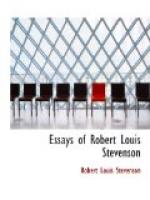the death of the heroine be somewhat frigid and artificial,
the last days of the hero strike the only note of
what we now call Byronism,[19] between the Elizabethans
and Byron himself. And yet a little story of
a ship-wrecked sailor, with not a tenth part of the
style nor a thousandth part of the wisdom, exploring
none of the arcana of humanity and deprived of the
perennial interest of love, goes on from edition to
edition, ever young, while
Clarissa lies upon
the shelves unread. A friend of mine, a Welsh
blacksmith, was twenty-five years old and could neither
read nor write, when he heard a chapter of
Robinson
read aloud in a farm kitchen. Up to that moment
he had sat content, huddled in his ignorance, but he
left that farm another man. There were day-dreams,
it appeared, divine day-dreams, written and printed
and bound, and to be bought for money and enjoyed
at pleasure. Down he sat that day, painfully learned
to read Welsh, and returned to borrow the book.
It had been lost, nor could he find another copy but
one that was in English. Down he sat once more,
learned English, and at length, and with entire delight,
read
Robinson. It is like the story of
a love-chase. If he had heard a letter from
Clarissa,
would he have been fired with the same chivalrous
ardour? I wonder. Yet
Clarissa has
every quality that can be shown in prose, one alone
excepted—pictorial or picture-making romance.
While
Robinson depends, for the most part and
with the overwhelming majority of its readers, on
the charm of circumstance.
In the highest achievements of the art of words, the
dramatic and the pictorial, the moral and romantic
interest, rise and fall together by a common and organic
law. Situation is animated with passion, passion
clothed upon with situation. Neither exists for
itself, but each inheres indissolubly with the other.
This is high art; and not only the highest art possible
in words, but the highest art of all, since it combines
the greatest mass and diversity of the elements of
truth and pleasure. Such are epics, and the few
prose tales that have the epic weight. But as
from a school of works, aping the creative, incident
and romance are ruthlessly discarded, so may character
and drama be omitted or subordinated to romance.
There is one book, for example, more generally loved
than Shakespeare, that captivates in childhood, and
still delights in age—I mean the Arabian
Nights—where you shall look in vain
for moral or for intellectual interest. No human
face or voice greets us among that wooden crowd of
kings and genies, sorcerers and beggarmen. Adventure,
on the most naked terms, furnishes forth the entertainment
and is found enough. Dumas approaches perhaps
nearest of any modern to these Arabian authors in
the purely material charm of some of his romances.
The early part of Monte Cristo, down to the
finding of the treasure, is a piece of perfect story-telling;
the man never breathed who shared these moving incidents




